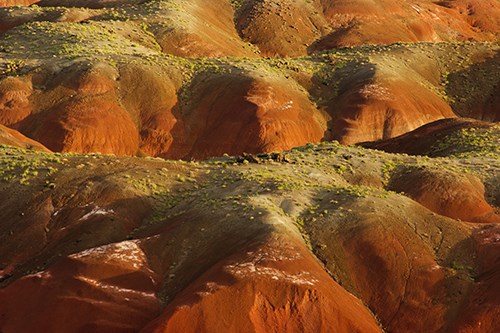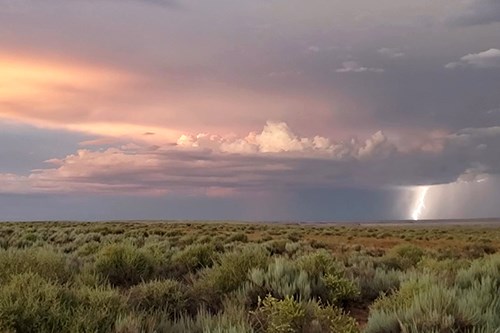
NPS Photo
There are many systems to classify environments and habitats developed by researchers and institutions over the years. One of the earliest in the West is the Life Zone concept developed by C. Hart Merriam in 1889 as a means of describing areas with similar plant and animal communities, particularly in the Western region. Merriam observed that the changes in these communities with an increase in latitude at a constant elevation are similar to the changes seen with an increase in elevation at a constant latitude. Much more detailed and empirically based classifications of vegetation and life zones now exist for most areas of the world. The Colorado Plateau is a geologic region characterized by different life zones. Life zones are defined by species of organisms, soils, climate, and other parameters. 
NPS/Stuart Holmes Badlands offer sparse vegetation. The clay soils are highly hydrophilic, expanding and contracting dramatically with precipitation or lack thereof. Without much in the way of food, shelter, or water, most animals pass through this area. However, take a walk among the badlands and you might see lizards, rodents, and birds. Plants include shadscale, annual wildflowers, and fluffgrass. Great places to see the Spartan badland habitat is the red part of the Painted Desert, the Tepees, and along the Blue Mesa Trail. 
The area above the rim of the Painted Desert in the middle distance is dominated by the semi-arid grassland. Most of the plants are native bunchgrasses with invasive non-native grasses, annual wildflowers and forbs. Hares, quail, lizards, pronghorn, and many types of songbirds make their home on the prairie. The best areas to experience the grassland is the interior of the road loop on HQ Mesa, along the park road from Nizhoni Point nearly to the Tepees, and meadows throughout the park. Shrubland The semi-arid shrubland grades from the grasslands to the higher elevations. The main plants include grasses, sagebrush, saltbush, shadscale, rabbitbrush, and buckwheat. Animals include a variety of rodents, reptiles, mule deer, raptors, and songbirds. Mesa tops throughout the park and graded into the grassland. 
NPS/Hallie Larsen The polka-dotted area of the pinyon-juniper woodland, dominated by pinyon pine, One-seed and Rocky Mountain juniper, cliffrose, along with buckwheat, ephedra, and annual and perennial wildflowers such as groundsel and Colorado 4 o’clock. Mule deer often browse here as well as cottontail rabbits. It is also home to mourning doves, scaled quail, bobcats, lizards, and coyotes. 
NPS/Hallie Larsen Riparian areas provide water for the species of the region, including the Puerco River. Cottonwoods, willow, rushes, cattails, birds, insects, and many others find food, water, and shelter near these water sources. Springs, seasonal rivers, intermittent water courses are just a few examples of wetland areas. |
Last updated: March 20, 2022
